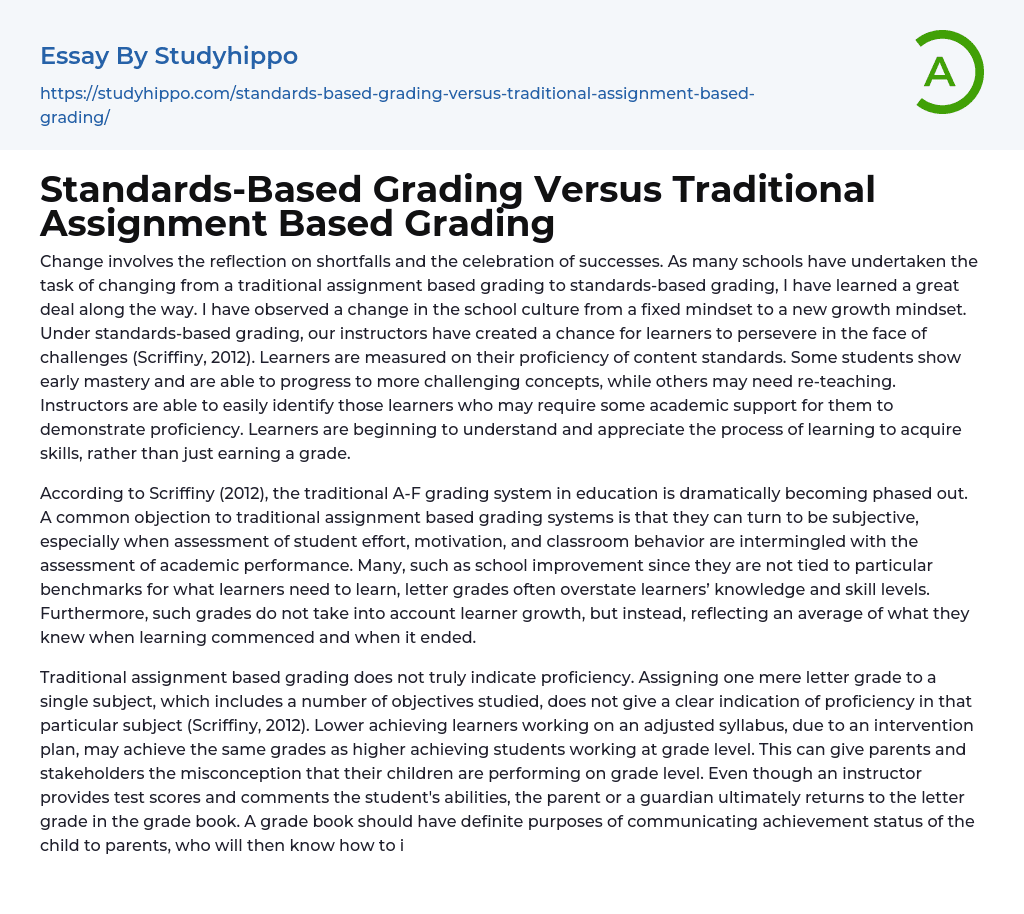

Standards-Based Grading Versus Traditional Assignment Based Grading Essay Example
Change involves the reflection on shortfalls and the celebration of successes. As many schools have undertaken the task of changing from a traditional assignment based grading to standards-based grading, I have learned a great deal along the way. I have observed a change in the school culture from a fixed mindset to a new growth mindset. Under standards-based grading, our instructors have created a chance for learners to persevere in the face of challenges (Scriffiny, 2012). Learners are measured on their proficiency of content standards. Some students show early mastery and are able to progress to more challenging concepts, while others may need re-teaching. Instructors are able to easily identify those learners who may require some academic support for them to demonstrate proficiency. Learners are beginning to understand and appreciate the process of learning to acquire skills, rather than just earning
...a grade.
According to Scriffiny (2012), the traditional A-F grading system in education is dramatically becoming phased out. A common objection to traditional assignment based grading systems is that they can turn to be subjective, especially when assessment of student effort, motivation, and classroom behavior are intermingled with the assessment of academic performance. Many, such as school improvement since they are not tied to particular benchmarks for what learners need to learn, letter grades often overstate learners’ knowledge and skill levels. Furthermore, such grades do not take into account learner growth, but instead, reflecting an average of what they knew when learning commenced and when it ended.
Traditional assignment based grading does not truly indicate proficiency. Assigning one mere letter grade to a single subject, which includes a number of objectives studied, does not give
clear indication of proficiency in that particular subject (Scriffiny, 2012). Lower achieving learners working on an adjusted syllabus, due to an intervention plan, may achieve the same grades as higher achieving students working at grade level. This can give parents and stakeholders the misconception that their children are performing on grade level. Even though an instructor provides test scores and comments the student's abilities, the parent or a guardian ultimately returns to the letter grade in the grade book. A grade book should have definite purposes of communicating achievement status of the child to parents, who will then know how to interpret the information.
The standards-based grading system has led to growth Mindset. Teachers are able to use continuous formative assessments to guide classroom instruction. In this system, students are able to practice their mastery of standards without the punishment of receiving a poor grade in the grade book. Additionally, the process of re-teaching opens an opportunity for both students and teachers to learn from their past mistakes (Scriffiny, 2012). The system also gives teachers opportunity to reflect on instruction in the classroom and evaluate if their lessons really met the needs of their learners. Students are able to concentrate their efforts on concepts they struggled to comprehend and the option for reassessment. Together, reassessment and re-teaching allow for all academic stakeholders to understand that intelligence can be developed and is not cast in stone.
Standards-based grading system requires the teacher to closely assess the actual standards of content and closely evaluate the predetermined objectives (Scriffiny, 2012). The system also allows teachers to clearly communicate with parents and students where individuals are with their understanding of each
concept. Students should be highly motivated toward mastery of content and not demotivated by working hard and still receiving a poor grade on an assessment, only to have to move to the next academic concept without gaining any insight.
Reference
- Scriffiny, P. L. (2012). Seven reasons for standards-based grading. Educational Leadership, 66(2), 70-74.
- History Of Education essays
- Graduate School essays
- Middle School essays
- School essays
- Special Education essays
- University essays
- Vocational Education essays
- College essays
- Student essays
- High School essays
- Elementary School essays
- Public School essays
- Single Sex Schools essays
- Kindergarten essays
- Teacher essays
- Classroom essays
- Examination essays
- E-Learning essays
- Homeschooling essays
- School Types essays
- Peer Group essays
- Professor essays
- Should College be Free essays
- Should college athletes be paid essays
- College Education essays
- College Tuition essays
- Graduation essays
- College Goals essays
- Personal Statement essays
- Online Classes Vs Traditional Classes essays
- Online Education essays
- Student Loan essays
- Study Abroad Scholarship essays
- Reasons To Go To College essays
- Paying College Athletes essays
- Technology In The Classroom essays
- Plans after High School essays
- High School Experience essays
- Classroom Management essays
- Academia essays
- Academic And Career Goals essays
- Academic Integrity essays
- Brainstorming essays
- Brown V Board of Education essays
- Brown Vs Board Of Education essays
- Coursework essays
- Curriculum essays
- Distance learning essays
- Early Childhood Education essays
- Education System essays



